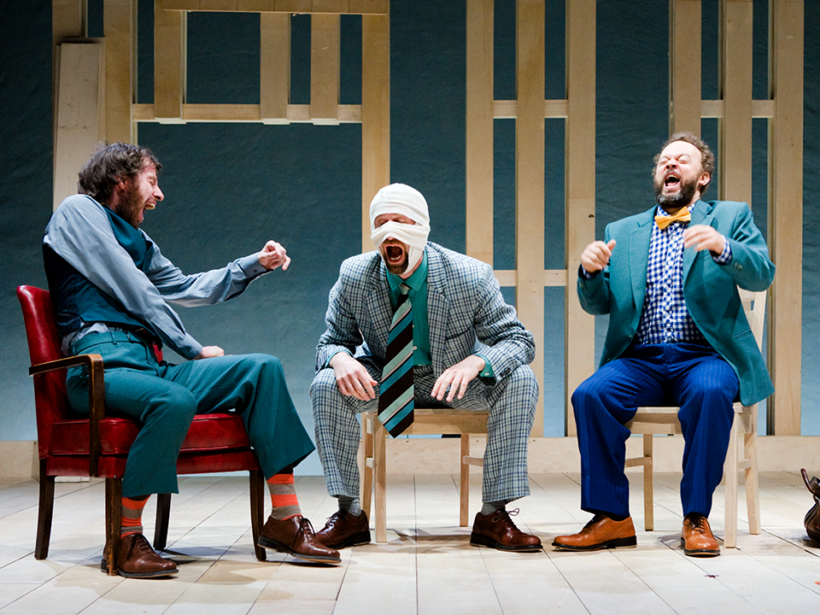Over the years I have slowly begun to realise that my own development and the development of the work I do in the theatre are one and same. When I become clear so does the work!
a body held ransom
In real time, in live theatre, the most exciting art of all, the actor’s body can sometimes betray the actor no matter how apparently ‘good,’ he or she is. If for example the actor is playing the role of Macbeth in a traditional setting, he may be able to remember his lines and he may have a strong and beautiful voice but if we, the audience can see by the size and shape of his gut and the weakness in his knees that he most probably has never ridden a horse our swung a broad sword with any real intent, we will be doomed to sit in disbelieving, disenchanted silence in the crowded seating bank for the duration of the production. Many times I have heard an actor’s voice expertly expressing an emotion and I see behind it, a body that is strangled, rigid and expressionless, a body held to ransom by that actor’s own limited range of movement, bearing little or no resemblance to the imagined body of the portrayed character expressing the given emotion.
In spite of everything we impose upon ourselves in an attempt to make life more pleasing we will always be fundamentally physical beings. We can never until death escape the structure that encases our minds and our souls. It is of the separation between the mental and the physical, the cerebral and the visceral, the internal and the external that we have to be mindful. Many actors are talking heads, others are headless bodies and some others have had any sense of their own natural physicality taken from them by the pursuit of an external manifestation of perfection.
It is of the separation between the mental and the physical, the cerebral and the visceral, the internal and the external that we have to be mindful.
When I work with a group it should be clear that everyone in that group is ready to undertake a process of daily training. If the body is not at a certain level of preparedness, injury can visit. When prepared, we work to unblock blockages, sensitise areas of insensitivity and slowly remove physical habits or impositions that have been accumulated over the years. Eventually and this can take many years, one may arrive back at a place where one’s body is open, free of mannerisms, sensitive and capable of working in unison with the mind.
Grotowski wrote that an actor can not truly become another person until the actor can truly and fully be themselves. I agree with this. How can we inhabit the physicality of a character we must play when we can not fully inhabit our own? In the world of the theatre we are obliged to discover our true natures, our true bodies and our true voices.
An actor can not truly become another person until the actor can truly and fully be themselves.
I no longer have any doubt that the external shape is a clear projection of the interior nature of a person. When I work to develop how a character might move, dance, talk or think, I look at the physical structure, the appearance of that character first. For example, is he tall, small, heavy or light? Does he move sharply or roll from one gesture to the next. How much tension does he hold in his muscles while resting? What element dominates his physicality, fire, water, wind or earth? What is his or her natural tempo, what is his rhythm? How does he breathe?
the landscape of the creation
I also work with sensation and energy. How do I feel when I visualise a certain type of person, either being that person or being in their company? Where does tension manifest in my body when I concentrate on this imagined character’s corporeal image; in the throat, the neck, the abdomen or pelvis? I see and then feel my way around the characters who will eventually occupy the landscape of the dance/theatre creation. These characters then become the building blocks of our productions.
A certain set of pre-existing physical characteristics automatically dictates how a person will move in space. Moving usually fully exposes the interior working of an actor or person. When we walk down the street we are all unconsciously sending thousands of mini-signals about who we are while passers by are unconsciously picking up these signals. With a well trained eye and a sensitive nature, one can read a person without hearing a word spoken. In this way words become secondary. The voice and its quality are secondary to that of the body and its quality. The voice is dependant on the body, in a sense the body is the voice.
With a well trained eye and a sensitive nature, one can read a person without hearing a word spoken.
Most actors’ faces are the most expressive and dextrous parts of their anatomy, closely followed by their hands. The rest of their instrument is often left behind in the shadows. However we can teach the less developed parts of our anatomy with the parts which you use more expertly. By relaxing the face we can in fact effect the relaxation of the body. By making a fist and squeezing it softly we can teach our abdomens the correct tone.
With the importance of the face in film, the lure of big money and the nature of our existing education system it is tempting and easy to leave a deeper exploration and understanding of the body behind but I would encourage you not to. Some day, somewhere you will an encounter a performer who has all aspects of his or her being highly developed and in equal measure and when you do, you will never forget the experience.
Michael Keegan Dolan, 2004



